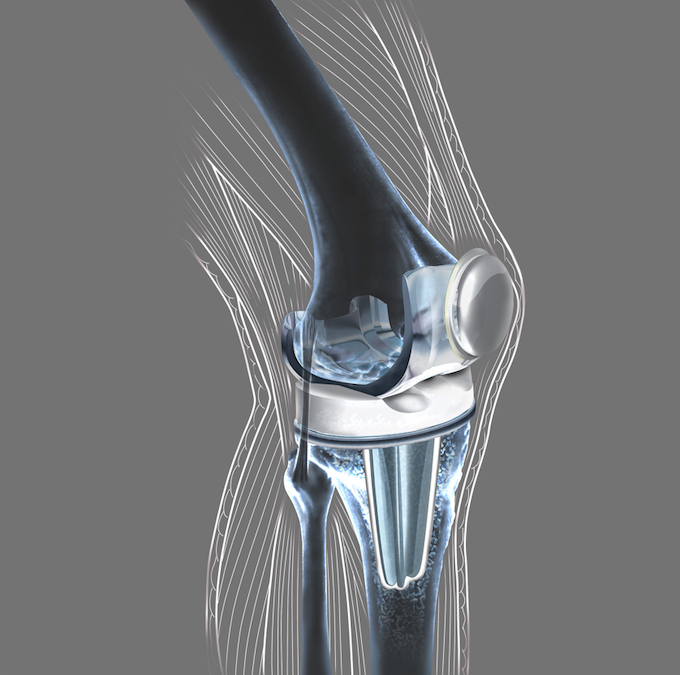How does a knee replacement stay in place?
When you have a knee replacement surgery, your surgeon will clear away the damaged knee joint surfaces and replace it with a prosthesis. A prosthesis is an artificial body part that can be made out of different materials. Your knee joint is stabilized and held in place by ligaments and tendons. But now, you have a prosthesis where your knee used to be, so how does it stay in place? Well, surgeons either will use a cemented or uncemented technique to fixate your new knee. To find out more about knee replacements check out "What is a total knee replacement?"

Image by DrDjJanek via Canva. Cemented and Uncemented are two fixation tehnciques to help secure your knee prosthesis during a knee replacement surgery.
Cemented and Uncemented fixation
Cemented fixation in knee replacement is considered the gold standard, the bee's knees. Approximately 93.5% of knee replacements use a cement fixation method.[4] This is in part due to excellent long term outcomes and low rates of loosening over time.[1] The method uses a fast drying (approx 10 min) type of bone cement to help fill the space between the prosthesis and the existing bone.[6] You can think of it like it is a type of grout. Advantages of using this method include:
- It is a good method for people with poor bone quality.[7]
- Antibiotics can be used in the cement to help decrease the risk of infection.[6]
- It can be done in a relatively short period of time so the surgeon can be confident of good fixation.[6]
Disadvantages include:
- The cement itself can begin to breakdown causing the need for a revision surgery.[6]
- Pieces of the cement can break off and irritate the surrounding tissue which may cause inflammation.[6]
Uncemented or cementless fixation is exactly what it sounds like, it doesn’t involve using cement. For this method of fixation, the surrounding bone must be healthy as the main idea behind this method is that your body will essentially fixate the prosthesis to keep it stable (pretty cool!).[1] Cementless fixations are then most commonly used for people 65 years and younger. Advantages to cementless fixation include:
- Better long term bond between bone and prosthesis.[6]
- Eliminates the worry for cement breakdown.
Disadvantages Include:
- Can only be used in younger adults with healthy bone.[3][6]
- It can take a while (up to 3 months) for bone material to grow to secure the prosthesis.[6]
This method also requires the surgeon to be more precise with clearing away damaged bone in order to securely fix the prosthesis. In cemented fixation, the surgeon can simply fill the gap with bone cement.

Image by Creativa Images via Canva. The wear and tear from daily activities can cause your knee prosthesis to become loose. Cemented fixation has been shown to last longer than uncemented.
Can a knee replacement become loose?
Even though there has been a lot of research into making sure your knee prosthetic stays securely in place, it still can become loose overtime. Just like our bodies, the knee prosthesis gets subjected to the wear and tear of daily activities, and thus has an effect on the fixation method holding your knee in place. The ideal fixation method is still a hot topic debate among the scholars of the knee replacement world. However, cemented fixation seems to last longer than uncemented fixation,[3] with cemented fixation lasting as long as 20 years.[2] Uncemented fixation has been shown to last equally as long but tends to overall be shorter than cemented fixation.[5] This is thought to be because younger individuals receiving uncemented fixation are more active and thus subject their knee to more wear and tear, leading to a need for early revision surgery.[2][3] It's not all bad news though, we have a blog on how long does a knee replacement last that is a great resource to learn more about preserving your knee replacement.
Conclusion
How does a knee replacement stay in place? Your surgeon will either fixate your knee prosthesis to your existing bone using two types of methods - cemented or uncemented. Cemented fixation uses a fast drying bone cement while uncemented fixation uses your existing bone to fit your new knee nice and snug. A lot of research has been done to make sure your knee replacement lasts long, but over time due to wear and tear your knee replacement can become loose. Cemented fixation does tend to last longer than uncemented fixation, but both are high quality techniques.
For more information on knee replacement and knee replacement recovery you can download the Curovate App. Curovate is a physical therapy app for patients for ACL, knee replacement, or hip replacement recovery. It provides a personalized physical therapy plan with video guided exercises to complete throughout each stage of the healing process, the chance to measure your range of motion, and more, all in the comfort of your own home. Proper rehabilitation can help preserve your knee replacement and improve your pain and activity levels. Click the links below to download the app!
If you need further customized assistance during your surgery or injury recovery check out our Virtual Physical Therapy page to book your 1-on-1 video session with a physical therapist.
 |
 |
|---|
Other Related Blogs
- What is a Total Knee Replacement
- How long will my knee replacement last? And is there anything I can do to make my knee replacement last longer?
- How is my body weight related to the success or failure of my knee replacement or hip replacement? Do I need to lose weight before my hip replacement or knee replacement?
- Am I too young to get a knee replacement?
- Should I put off my total knee replacement surgery? Am I waiting too long for my knee replacement? What are my other options?
- What kind of exercises and sports can I do after a total knee replacement?







